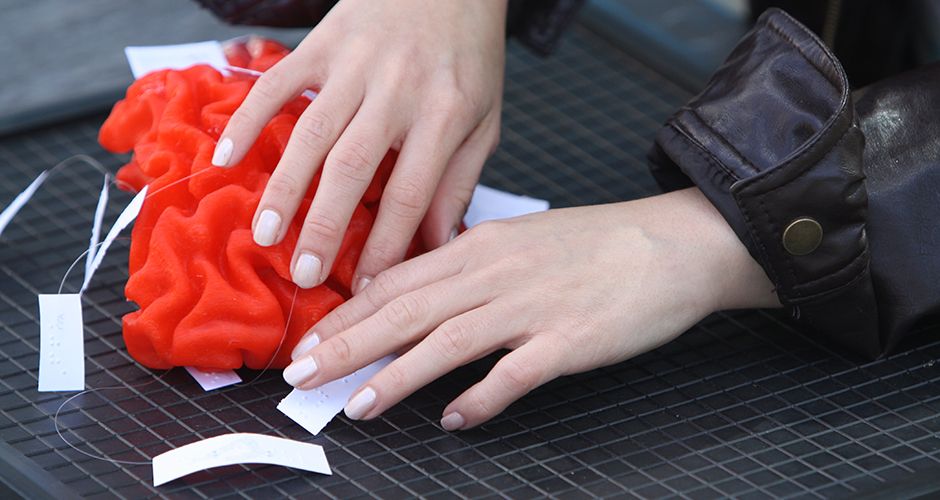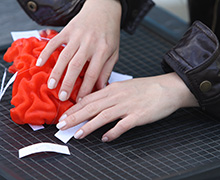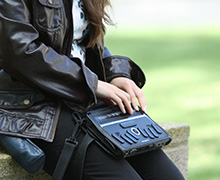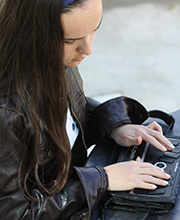Seeing things differently

Seeing things differently
- February 23, 2016
- First year grad student studies working memory variations in visually impaired and sighted individuals
-----
 Graduate student Karen Arcos explored the UCI campus extensively before she arrived
for her first quarter in the Department of Cognitive Sciences. She learned walking
routes to labs and classrooms, and became familiar with identifying landmarks around
campus—she even learned train travel. Many incoming students adopt a more casual,
‘I’ll figure it out’ attitude, but for Arcos—who is totally blind—that wasn’t an option.
Graduate student Karen Arcos explored the UCI campus extensively before she arrived
for her first quarter in the Department of Cognitive Sciences. She learned walking
routes to labs and classrooms, and became familiar with identifying landmarks around
campus—she even learned train travel. Many incoming students adopt a more casual,
‘I’ll figure it out’ attitude, but for Arcos—who is totally blind—that wasn’t an option.
The National Science Foundation Graduate Research Fellow has faced many challenges
to get to where she is today—that is, completing a prestigious Ph.D. program with
a nationally renown fellowship under her belt. So taking these extra steps to prepare
for her arrival at UCI was nothing out of the ordinary. Her research proposal to the
NSF tackles one such challenge in particular—the decline of braille usage among the
visually impaired.
According to Arcos, research shows that when a person reads using braille, the area
of the brain that activates when sighted people read print—the visual cortex—activates
in non-sighted readers as well. She would like to find out what this means for reading
comprehension, and as a first step, she seeks to understand how working memory ability
varies among braille readers and non-braille readers.
 “Braille is starting to die out, and a lot of people see screen readers as the way
to go in terms of reading information because it’s a lot faster,” Arcos says. “But
if you’re just listening to text all day, how are you going to learn spelling or punctuation?
How will you learn where the top of the page is relative to the bottom, or even what
indenting is? You can’t understand spatial layout through listening in the way that
braille offers.”
“Braille is starting to die out, and a lot of people see screen readers as the way
to go in terms of reading information because it’s a lot faster,” Arcos says. “But
if you’re just listening to text all day, how are you going to learn spelling or punctuation?
How will you learn where the top of the page is relative to the bottom, or even what
indenting is? You can’t understand spatial layout through listening in the way that
braille offers.”
As Arcos relies on a strategic combination of screen readers and braille for everything
from schoolwork to getting directions, she’s found the diminishment of braille resources
to be troubling. She hopes that through this proposed research—utilizing fMRI to determine
how reading comprehension is affected by the medium used—she can justify more focus
on braille education.
“I propose to do research looking at how people comprehend information depending on
the environment they’re placed in,” she says. “When you’re visually impaired, you
access information in different ways. Whether it be a human reader—like having a friend
read a restaurant menu to you; versus reading with a screen reader; versus reading
in braille; versus reading in large print if you have some vision. I want to look
at how reading mediums affect your long-term comprehension.”
To aid her in her quest for answers, Arcos’ faculty advisor Emily Grossman, cognitive
sciences professor, secured a UCI ADVANCE Spirit Grant, which will fund the development of computing tools to make brain imaging data analytic
software—essential for Arcos’ research—accessible to the visually impaired. In fact,
Arcos is incredibly grateful for just how encouraging Grossman and the Disability
Services Center staff at UCI have been.  “I went from hearing all these no’s [from other schools] to her saying ‘Oh, I’ve never
worked with blind people before, but your research sounds so interesting, let’s talk
about it,’” Arcos says of Grossman. “She was really enthusiastic from the get go,
which is what I was looking for—supportive faculty."
“I went from hearing all these no’s [from other schools] to her saying ‘Oh, I’ve never
worked with blind people before, but your research sounds so interesting, let’s talk
about it,’” Arcos says of Grossman. “She was really enthusiastic from the get go,
which is what I was looking for—supportive faculty."
This support has been especially welcome considering that Arcos has strived to prove
her capabilities since elementary school. Actually, she’s been fighting the odds since
birth.
Arcos was born several months premature in a country unfamiliar to her mother, who
was visiting from Colombia. Delivered at only 23 weeks, it was unclear at first whether
the infant would even survive. She had quite a fight ahead of her, but after being
hospitalized for three months, Arcos was finally strong enough to enter the real world.
It wasn’t long before her mother realized that the baby wasn’t responding to visuals.
Doctors confirmed that both Arcos’ retinas were detached, and she had only light perception.
“I was the first in the family to have something like this happen, so my mother had
no idea what to do, where to go, or how to seek help,” Arcos says. “She was a first-time
mom, and to raise a child that has a disability in a foreign country with only some
understanding of English is even more challenging. She’s my lifesaver—both my parents
are.”
The family found support and resources at the nonprofit Blind Children’s Center in
Los Angeles. There, six-month-old Arcos and her family learned how to manage life
without sight—and she volunteers there to this day.
“While my mom was learning how to make the home environment accessible, how to come
to terms with my diagnosis, and to accept stares from strangers, I was learning how
to use a white cane and learning pre-braille skills,” Arcos explains. “Sighted kids
start to learn to read and write, whereas I was learning how to move my hands across
a page or to strengthen my fingers to eventually use equipment to read and write braille
in the future.”
Arcos doesn’t sugar coat the fact that being visually impaired in a sighted world
is difficult, but the staff at the Blind Children’s Center always stressed that she
didn’t have to change her goals just because she couldn’t see. After graduating from
the Center at age five, Karen learned braille at a special public school for the blind,
followed by mainstreaming to elementary school. Here, she hit one of her first big
hurdles when the new school was hesitant to test Arcos for Gifted and Talented Education,
claiming it would be difficult for her to keep up with the advanced course load. But
Arcos and her parents pushed back. It paid off, and she participated in accelerated
coursework through high school.
Having her parents in her corner as advocates taught Arcos to fight for herself, and
not to take ‘no’ for an answer. This perseverance came in handy when, as a high school
student, she once again had her abilities questioned by school authority figures.
This time, they suggested that her goal of going to a four-year university was not
advisable.
“The special education transition staff, who are meant to help students with disabilities
find resources for after high school, were hesitant, too,” she says. “They encouraged
me to attend community college or an independent living skills center because they
were concerned that being on my own at a university would be too difficult.”
Arcos had always wanted to go to a four-year college, so these attitudes were discouraging.
“When I was growing up, my parents would ask me ‘where are you going?’ and I would
have to fill in the blank—first preschool, then elementary school, then middle school,
high school and, finally, university.”
So, instead of accepting their suggestions, she applied to QuestBridge National College
Match, a program that helps high-achieving, low-income high school students acquire
four-year scholarships to some of the nation’s top universities. This decision led
her to accept a four-year scholarship to the University of Southern California.
“I think I’ve learned resilience and perseverance because of all the no’s I’ve heard,”
she says. “And creativity—I’ve learned to think outside the box to find solutions
to difficulties that others might not have.”
This knack for finding solutions led to her research interests as an undergrad and
as a McNair Scholar. It was at USC, while studying psychology and Spanish, that the
newly-minted Trojan noticed the lack of visually impaired students and faculty on
campus: Arcos was one of only four students, the only female, and the only braille
reader. This knowledge, coupled with her continued volunteer work at the Blind Children’s
Center and co-founding of a support group—Survive or Thrive—to help students with disabilities and their families plan post high school goals,
brought her to the question of why braille was becoming extinct.
“Part of what got me interested in the topic is that it’s under-researched in the
first place,” Arcos says. “From the literature I’ve read, studies mainly address reading
fluency rather than retention or comprehension. In addition, the number of participants
in the research is not very high. It comes back to us being such a small population.
According to the Department of Education, blind students comprise less than half of
one percent of the school-aged population nationwide. And of that small percentage,
ninety percent do not read braille. If you imagined that with print, where would society
be?”
As she approached commencement, Arcos proposed her research to graduate programs across
the country—and received plenty of rejections. Instead of getting discouraged, however,
she kept trying and, again, her persistence paid off—she impressed faculty at both
UCI and Harvard. Though she was tempted by the allure of the Ivy League, ultimately
it was Grossman and UCI that made the biggest impact on her.
Now, Arcos is focusing on finishing her first year on campus on a high note and finding
her groove with the workload. She is also calculating just how she will utilize the
$46,000 grant from NSF.
In addition, she stays plenty busy outside of academics, having recently completed
her 18th 5K as part of the LA Marathon in benefit of the Blind Children’s Center, and advocating for an amendment to the Americans
with Disabilities Act to make online information accessible to people with disabilities.
Obstacles or not, it’s clear that no matter where this Anteater is, she will be championing
for change.
—Bria Balliet, School of Social Sciences
pictured (in order): Arcos' hands with 3D printed brain and braille labels. Arcos sitting on ledge reading BrailleNote Apex. Arcos typing on BrailleNote Apex.
-----
Would you like to get more involved with the social sciences? Email us at communications@socsci.uci.edu to connect.
Share on:
Related News Items
- Careet RightDickson receives grant to apply computational cognitive models to language acquisition
- Careet RightSocial sciences research at risk
- Careet RightUCI study finds adults who are blind possess memory perks
- Careet RightAttending the National Conference for Black Political Scientists
- Careet RightSuperior recall


